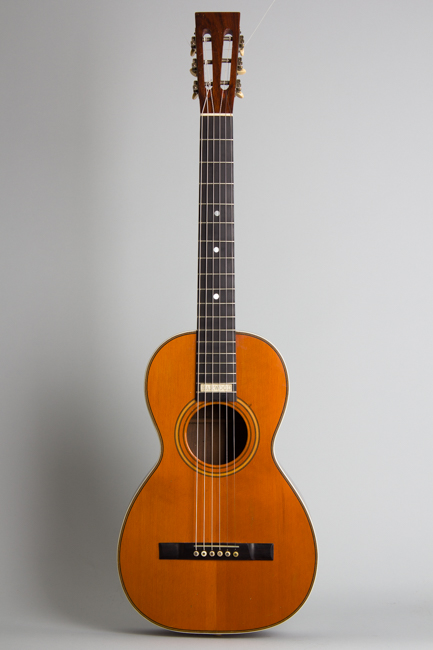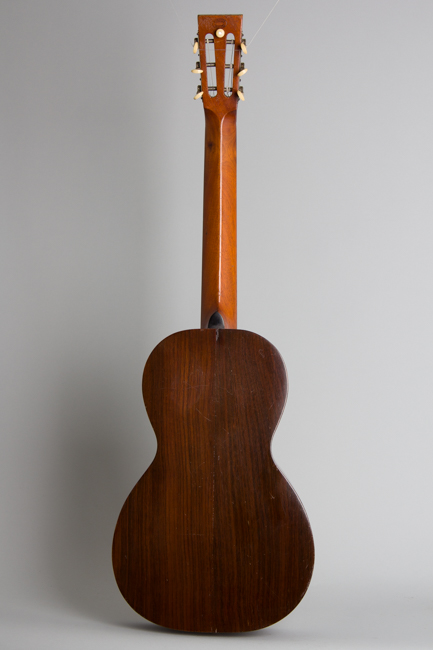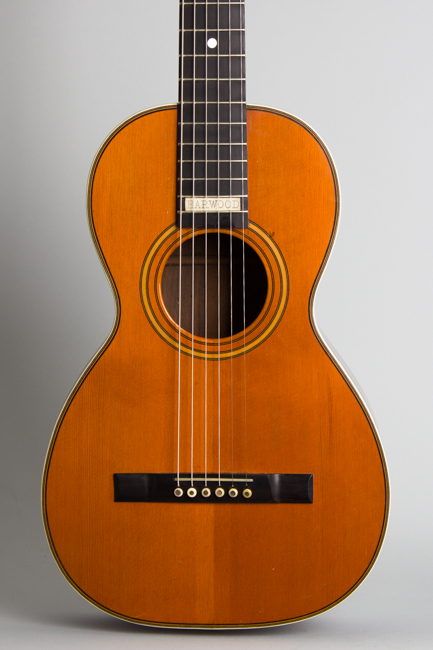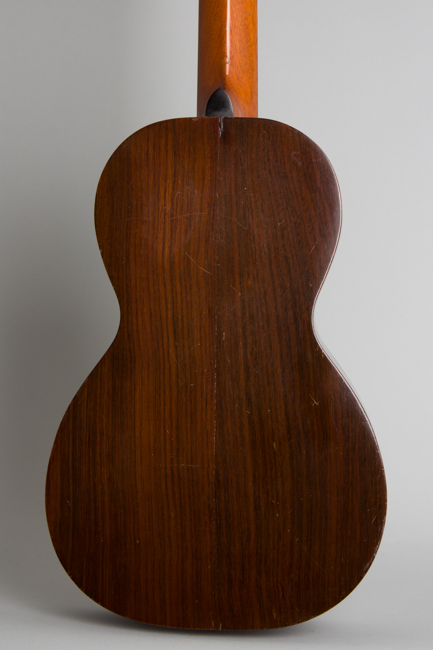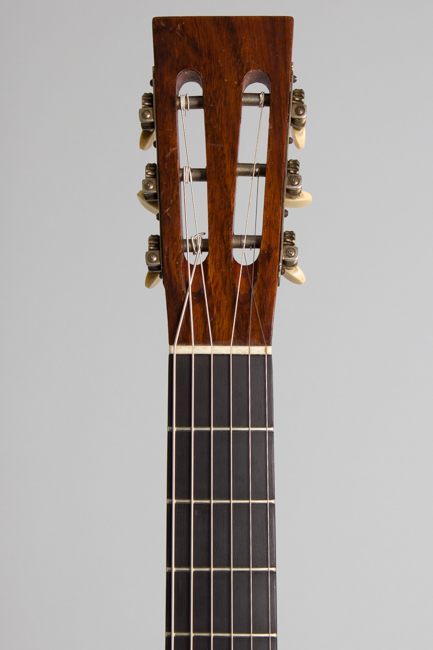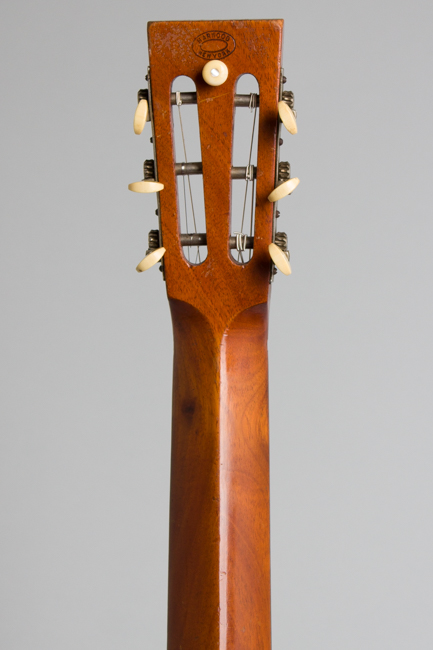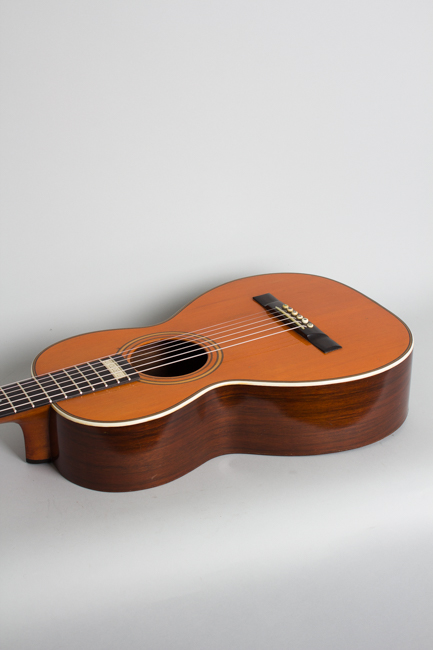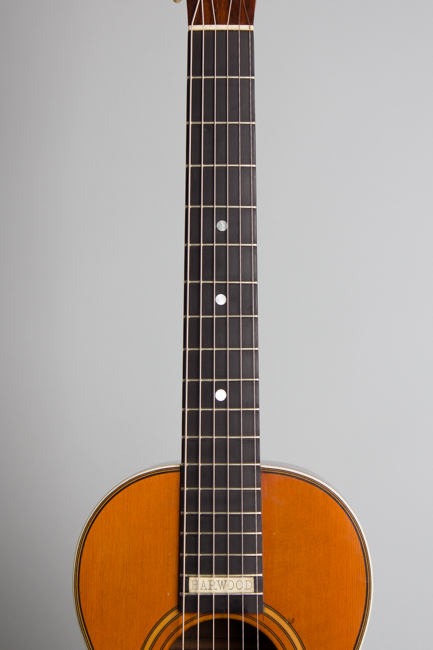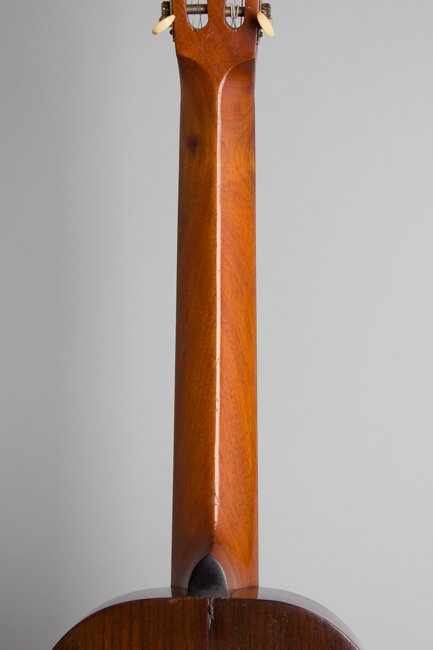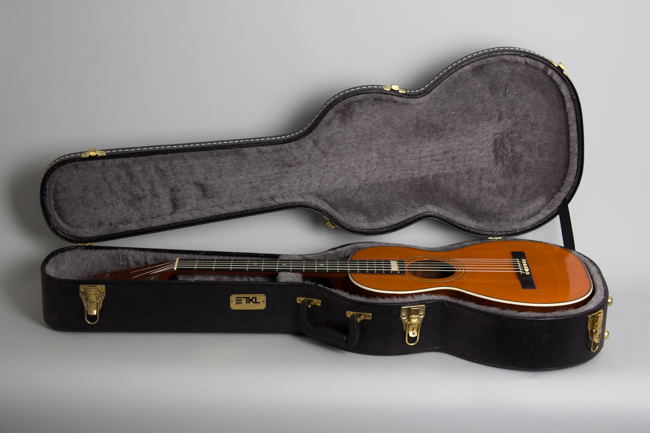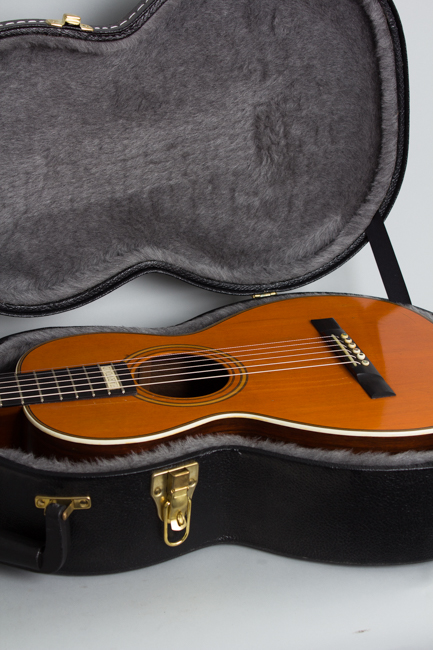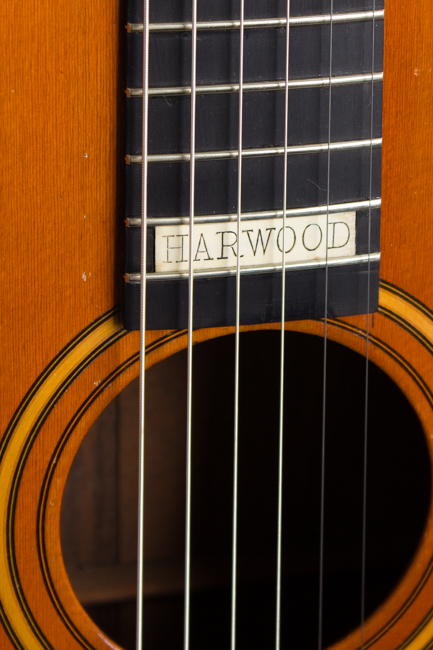Harwood Parlor Guitar , c. 1915
Harwood Parlor Guitar, c. 1915, made in Kansas City, serial # 21051, natural varnish finish, rosewood back and sides, spruce top, black tolex hard shell case.
"Harwood" has long been one of those mystery brand names that dotted the American musical instrument landscape of the pre-depression age. In late 19th and early 20th centuries this trademark brand was used by J.W. Jenkins Sons of Kansas City, one of the west's biggest jobbers for their best quality instruments. Some earlier examples are marked "Harwood-New York" but no connection to an actual New York origin is evident. Perhaps folks in Kansas City were expected to be impressed that the instruments came from the Metropolis so far away!
After sourcing some early models from the John C. Haynes company in Boston, starting in 1895 Jenkins themselves operated a small factory in Kansas City for over 30 years building fairly high-grade fretted merchandise. While in some ways similar to the best Chicago made instruments of the time the workmanship is at a higher level than many, near the Lyon & Healy standard. While their origin long proved elusive, Harwood instruments that survive are generally very well made of top quality materials, and were fairly expensive when new.
This is a very small guitar by modern standards, "standard" size in Jenkins' nomenclature; Harwoods were offered in several larger sizes by 1918. It has an 11 3/16" lower bout but a full 24 1/2" scale neck, so is not technically a 3/4 size instrument. The woods are high-grade throughout and the workmanship is excellent. Like most Harwood models this guitar is built using beautiful Brazilian rosewood on the back and sides and an incredibly tight-grained top described by Jenkins as "Norway Spruce". This is ladder braced in "the Harwood System" and has survived 100+ years with hardly any bellying at all. The top is edged with single layered white binding surrounding wood strips, the soundhole has multiple celluloid strips with a thick center.
The neck has an ebony fingerboard carrying three large pearl dot markers. One unique touch is an engraved celluloid "Harwood" logo plate inlaid between two high frets. The single-plate tuners on the slotted headstock are the same keys used by the Larsons, Martin, National and others in the 1910's and '20's. There is an extra endpin in the back of the headstock, a charming 19th century touch. There is a diamond shaped stamp on the heelblock proclaiming "Genuine Harwood, trade mark registered".
Jenkins claimed that the Harwood line were the finest guitars built, and while C.F. Martin or Lyon & Healy might have begged to differ this is a very nicely made instrument. It appears to date to the mid 1910's at the latest. Harwood instruments bear serial numbers on the headstock that appear to be sequential but no key to provide exact dating survives. The brand continued into the 1920's but was discontinued when the depression hit, never to be revived.
As a playing instrument this guitar has a lovely sound strung with Silk & Steel strings. The tone is bright but even with some of the tight attack typical of straight braced guitars. In both material and construction is a superb instrument; If Jenkins' workmen had copied the Martin or Washburn X-braced system these would be much better known guitars. As it stands at well over 100 years old remains an excellent playing instrument and a tribute to the forgotten Kansas city team that built it.
Overall length is 36 in. (91.4 cm.), 11 3/16 in. (28.4 cm.) wide at lower bout, and 3 11/16 in. (9.4 cm.) in depth at side, taken at the end block. Scale length is 24 1/2 in. (622 mm.). Width of nut is 1 13/16 in. (46 mm.).
This is an amazingly clean and well-preserved guitar for being over 100 years old, and an excellent playing instrument. The original very thin varnish finish shows some typical micro-checking with a few sworn-through spots and small dings, dents and scrapes but really no heavy wear. Improbably there are none of the common spruce or rosewood body cracks or major repairs either. The parts appear original including the strip tuners and bone bridge pins.
The neck has been neatly reset to the original uncut bridge and the ebony fingerboard refretted with appropriate wire. The original bridge has been reglued and a thin crack through the pins solidly resealed. This all makes for a high-grade, small body 19th century style parlor instrument fully playable to modern standards, which is a fairly rare combination. Due to the very light ladder-braced construction this guitar is recommended for silk and steel stringing only; as such is has a very easy action and lovely chime-like sound. It is housed in a good modern HSC. Overall Excellent Condition.
"Harwood" has long been one of those mystery brand names that dotted the American musical instrument landscape of the pre-depression age. In late 19th and early 20th centuries this trademark brand was used by J.W. Jenkins Sons of Kansas City, one of the west's biggest jobbers for their best quality instruments. Some earlier examples are marked "Harwood-New York" but no connection to an actual New York origin is evident. Perhaps folks in Kansas City were expected to be impressed that the instruments came from the Metropolis so far away!
After sourcing some early models from the John C. Haynes company in Boston, starting in 1895 Jenkins themselves operated a small factory in Kansas City for over 30 years building fairly high-grade fretted merchandise. While in some ways similar to the best Chicago made instruments of the time the workmanship is at a higher level than many, near the Lyon & Healy standard. While their origin long proved elusive, Harwood instruments that survive are generally very well made of top quality materials, and were fairly expensive when new.
This is a very small guitar by modern standards, "standard" size in Jenkins' nomenclature; Harwoods were offered in several larger sizes by 1918. It has an 11 3/16" lower bout but a full 24 1/2" scale neck, so is not technically a 3/4 size instrument. The woods are high-grade throughout and the workmanship is excellent. Like most Harwood models this guitar is built using beautiful Brazilian rosewood on the back and sides and an incredibly tight-grained top described by Jenkins as "Norway Spruce". This is ladder braced in "the Harwood System" and has survived 100+ years with hardly any bellying at all. The top is edged with single layered white binding surrounding wood strips, the soundhole has multiple celluloid strips with a thick center.
The neck has an ebony fingerboard carrying three large pearl dot markers. One unique touch is an engraved celluloid "Harwood" logo plate inlaid between two high frets. The single-plate tuners on the slotted headstock are the same keys used by the Larsons, Martin, National and others in the 1910's and '20's. There is an extra endpin in the back of the headstock, a charming 19th century touch. There is a diamond shaped stamp on the heelblock proclaiming "Genuine Harwood, trade mark registered".
Jenkins claimed that the Harwood line were the finest guitars built, and while C.F. Martin or Lyon & Healy might have begged to differ this is a very nicely made instrument. It appears to date to the mid 1910's at the latest. Harwood instruments bear serial numbers on the headstock that appear to be sequential but no key to provide exact dating survives. The brand continued into the 1920's but was discontinued when the depression hit, never to be revived.
As a playing instrument this guitar has a lovely sound strung with Silk & Steel strings. The tone is bright but even with some of the tight attack typical of straight braced guitars. In both material and construction is a superb instrument; If Jenkins' workmen had copied the Martin or Washburn X-braced system these would be much better known guitars. As it stands at well over 100 years old remains an excellent playing instrument and a tribute to the forgotten Kansas city team that built it.
Overall length is 36 in. (91.4 cm.), 11 3/16 in. (28.4 cm.) wide at lower bout, and 3 11/16 in. (9.4 cm.) in depth at side, taken at the end block. Scale length is 24 1/2 in. (622 mm.). Width of nut is 1 13/16 in. (46 mm.).
This is an amazingly clean and well-preserved guitar for being over 100 years old, and an excellent playing instrument. The original very thin varnish finish shows some typical micro-checking with a few sworn-through spots and small dings, dents and scrapes but really no heavy wear. Improbably there are none of the common spruce or rosewood body cracks or major repairs either. The parts appear original including the strip tuners and bone bridge pins.
The neck has been neatly reset to the original uncut bridge and the ebony fingerboard refretted with appropriate wire. The original bridge has been reglued and a thin crack through the pins solidly resealed. This all makes for a high-grade, small body 19th century style parlor instrument fully playable to modern standards, which is a fairly rare combination. Due to the very light ladder-braced construction this guitar is recommended for silk and steel stringing only; as such is has a very easy action and lovely chime-like sound. It is housed in a good modern HSC. Overall Excellent Condition.
